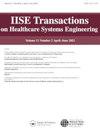应用区块链技术形成医院协作网络减少血小板浪费和短缺
IF 1.5
Q3 HEALTH CARE SCIENCES & SERVICES
IISE Transactions on Healthcare Systems Engineering
Pub Date : 2020-12-17
DOI:10.1080/24725579.2020.1864522
引用次数: 5
摘要
摘要鉴于血液制品的保质期短,供血人口减少,医院努力实现短缺和过时之间的平衡。虽然医院之间的合作和共享血液将导致合理的盈余和赤字减少,但由于可追溯性问题,卫生法规强烈阻止医院之间的血液交换。随着最近点对点网络的发展,区块链已被用于记录企业中的交易,其优势是具有时间戳。这项研究是第一个使用区块链技术解决血液库存管理问题的研究之一,通过形成医院合作网络并在该系统中交换血液,实现透明度和可追溯性。提出了一种新的聚类技术,称为多标准聚类(MCC),使用混合整数规划方法来形成区块链网络,该网络基于许多相互冲突的标准(如协作偏好、地理分布、医院规模和运营异质性)进行聚类决策。随后,开发了一个数学模型,以确定区块链网络中每个医院的采购策略,并在该网络中的其他医院之间提供共享血液的机会。这种两阶段的方法在大都市附近的医院环境中进行了测试。通过敏感性分析来评估区块链系统在成本、保质期、需求分布和需求变化系数方面的有效性。根据结果,可以得出结论,尽管会产生额外的区块链开发和运营费用,但对于所有设置,拟议的区块链网络都明显优于目前拥有独立运营医院的系统。本文章由计算机程序翻译,如有差异,请以英文原文为准。
Application of blockchain technique to reduce platelet wastage and shortage by forming hospital collaborative networks
Abstract Given the short shelf life of blood products and a decrease in donor population, hospitals endeavor to achieve an equilibrium between shortage and outdating. Though collaborating and sharing blood among hospitals will result in a reasonable reduction in surplus and deficit, health regulations strongly discourage blood exchange among hospitals due to traceability issues. With the recent advancement in peer-to-peer networking, blockchains have been used for record transactions in businesses with the advantage of being timestamped. This research is one of the first to address the blood inventory management problem using the blockchain technique by forming a collaborative network of hospitals and exchanging blood in that system, enabling transparency and traceability. A novel clustering technique, called multi-criteria clustering (MCC), using a mixed-integer programming approach, is proposed to form the blockchain network that bases its clustering decisions on a number of conflicting criteria, such as collaboration preference, geographical distribution, hospital size, and operational heterogeneity. Subsequent to this, a mathematical model is developed to identify purchasing strategies for each hospital in a blockchain network, given the opportunity to share blood among other hospitals in that network. This two-phase approach is tested using hospital settings in a neighborhood of a metropolitan city. Sensitivity analysis is performed to evaluate the effectiveness of the blockchain system with respect to change in cost, shelf life, demand distribution, and coefficient of demand variation. Based on the results, it can be concluded that, for all settings, the proposed blockchain network significantly outperforms the current system with independently acting hospitals, in spite of the additional blockchain development and operating expenses that are incurred.
求助全文
通过发布文献求助,成功后即可免费获取论文全文。
去求助
来源期刊

IISE Transactions on Healthcare Systems Engineering
Social Sciences-Safety Research
CiteScore
3.10
自引率
0.00%
发文量
19
期刊介绍:
IISE Transactions on Healthcare Systems Engineering aims to foster the healthcare systems community by publishing high quality papers that have a strong methodological focus and direct applicability to healthcare systems. Published quarterly, the journal supports research that explores: · Healthcare Operations Management · Medical Decision Making · Socio-Technical Systems Analysis related to healthcare · Quality Engineering · Healthcare Informatics · Healthcare Policy We are looking forward to accepting submissions that document the development and use of industrial and systems engineering tools and techniques including: · Healthcare operations research · Healthcare statistics · Healthcare information systems · Healthcare work measurement · Human factors/ergonomics applied to healthcare systems Research that explores the integration of these tools and techniques with those from other engineering and medical disciplines are also featured. We encourage the submission of clinical notes, or practice notes, to show the impact of contributions that will be published. We also encourage authors to collect an impact statement from their clinical partners to show the impact of research in the clinical practices.
 求助内容:
求助内容: 应助结果提醒方式:
应助结果提醒方式:


